#React Native vs Flutter app development
Explore tagged Tumblr posts
Text
React Native Vs. Flutter: Which Framework is Right for Your App?
In this blog we shares all about React Native Vs. Flutter: Which Framework is Right for Your App? And When to Choose Flutter App Development, When to Choose React Native App Development. If you want to Build the best mobile application development company in Rajkot, Contact Aphonic Solutions now!

#cross-platform app development#mobile application development company in Rajkot#React Native Vs. Flutter#When to Choose Flutter App Development#When to Choose React Native App Development
0 notes
Text
Flutter vs. React Native: Best Framework for Your Cross-Platform App

Choosing the right framework is critical to the success of your app. In the world of cross-platform development, React Native and Flutter stand out as the go-to choices for building apps efficiently for Android and iOS from a single codebase. Both frameworks offer unique advantages, but which one is best suited for your project? Let’s dive in to help you decide.
Understanding React Native
React Native, created by Facebook in 2015, enables developers to create mobile applications using JavaScript. By extending the popular React framework for web development to mobile platforms, React Native simplifies development without sacrificing a native-like user experience.
Key Features of React Native:
Reusable Codebase: Write once, run on both Android and iOS with minimal adjustments.
Native Rendering: Uses native UI components, ensuring apps look and feel like true native apps.
JavaScript Expertise: Leverages an already widely used programming language, reducing the learning curve for teams.
Ideal Use Cases:
React Native excels in developing apps that prioritize functionality, such as:
Social Media Apps: Facebook and Instagram are prime examples.
E-commerce Apps: Platforms focusing on core features and fast iteration.
MVPs for Startups: Quick time-to-market with robust functionality.
When it comes to custom mobile app development, React Native provides a practical solution for businesses aiming to deliver apps across multiple platforms while optimizing time and costs.
Flutter: Google’s Vision for Cross-Platform Apps
Launched in 2017, Flutter is Google's open-source framework for creating visually stunning and highly performant apps. Powered by Dart, Flutter is designed for developers who value consistent design and seamless performance across platforms, including mobile, web, and desktop.
Key Features of Flutter:
Rich Widgets Library: A customizable set of widgets allows precise control over UI design.
Hot Reload: Real-time changes boost productivity during development.
Platform Independence: Build apps that scale beyond mobile to web and desktop platforms.
Ideal Use Cases:
Flutter shines in applications requiring advanced graphics and consistency, such as:
Graphically Intense Apps: Complex animations and interactive designs.
Multi-Platform Apps: Apps needing a unified experience across devices.
Startups with Design-First Focus: Beautiful, responsive apps built efficiently.
For developers focused on web app development, Flutter's multi-platform capabilities make it an excellent choice for creating seamless digital experiences across devices.
What Are the Key Differences Between Flutter and React Native?
When deciding between Flutter and React Native, it's essential to understand their key differences to choose the right framework for your project.
1. Programming Language
React Native uses JavaScript, making it a natural choice for teams with web development experience.
Flutter uses Dart, which offers robust features but has a smaller developer community.
2. UI/UX Customization
React Native relies on native components, providing a consistent platform look but less flexibility for custom UI designs.
Flutter uses its widget-based system, enabling highly customizable and visually consistent designs.
3. Performance
React Native uses a JavaScript bridge, which may impact performance in graphics-heavy apps.
Flutter compiles directly to native code, ensuring better performance for complex animations and high-performance apps.
4. Multi-Platform Support
React Native focuses on mobile, with third-party tools enabling web functionality.
Flutter natively supports mobile, web, and desktop, making it a more versatile choice.
Advantages and Disadvantages of React Native and Flutter
When choosing between React Native and Flutter, understanding their pros and cons can help streamline your decision for mobile app development.
React Native: Pros and Cons
Advantages
Large Community Support: Built on JavaScript, React Native benefits from a vast developer community and numerous libraries.
Faster Development: If you’re familiar with JavaScript and React, React Native allows faster transitions into mobile app development.
Cost Savings: A single codebase works for both iOS and Android, reducing resources.
Disadvantages
Performance Issues: May struggle with complex animations or graphics due to the JavaScript bridge.
Limited Customization: Relies on native components, limiting UI design options.
Dependency on Third-Party Libraries: Advanced features depend on third-party tools, which can cause delays.
Flutter: Pros and Cons
Advantages
Superior Performance: Compiles directly to native code, improving speed, especially for animations.
Highly Customizable UI: Uses widgets for advanced and flexible UI design.
Single Codebase Across Platforms: Works for mobile, web, and desktop development.
Disadvantages
Larger File Size: Flutter apps consume large amount of storage
Limited Dart Expertise: Dart is less common than JavaScript, making skilled developers harder to find.
Still Maturing for Web Support: Flutter’s web capabilities are still evolving, with some performance and compatibility challenges.
Future of Cross-Platform Development
The demand for cross-platform frameworks continues to grow, driven by the need to build apps efficiently for multiple platforms. React Native and Flutter are both evolving rapidly, supported by major tech companies like Facebook and Google. While React Native leads in market share, Flutter’s rich UI capabilities and growing popularity make it a serious contender.
React Native or Flutter : Which one to pick
The choice between Flutter and React Native depends on your project goals, team expertise, and app requirements. Both frameworks are powerful tools that cater to different needs, ensuring you can deliver an excellent user experience.
#web development#app developing company#web app development#Flutter vs. React Native#best app development framework
0 notes
Text

Flutter vs React Native- every investor questions which is the best platform for their app development as they need a fully optimal solution for their business growth. Although the debate between Flutter and react native is nonnegotiable, both platforms have their USP, so let’s understand which is the most preferable framework as per your needs.
#Flutter App Development Company#Flutter vs React Native#Flutter App Development Services#Flutter and React Native
0 notes
Text
In this guide, we compare Flutter vs. React Native for 2024. Explore their unique features, performance differences, and when to choose each framework.
#Flutter App Development Company#React Native App Development Company#Flutter Mobile App Development#Mobile App Development#Moweb Technologies#Flutter vs React Native#Best Guide for Flutter vs React Native
0 notes
Text
youtube
Are you struggling to decide between Flutter and React Native for your next app project?
Join us as we break down the pros and cons of both frameworks. We'll compare their performance, learning curve, cross-platform compatibility, and more to help you make an informed decision.
Key points covered:
1. Performance: Which framework is faster?
2. Learning curve: Which is easier for beginners?
3. Cross-platform compatibility: How well do they work on iOS and Android?
4. Community support: Which has a larger and more active community?
Whether you're a seasoned developer or just starting out, this video will provide valuable insights to help you choose the right framework for your app.
#app development#app developer#flutter vs react native#flutter app development#reactnative app developement#Youtube
0 notes
Text
0 notes
Text
Exploring Cross-Platform Development: Flutter vs. Xamarin vs. React Native
Cross-platform development has become increasingly popular in the mobile app development landscape, allowing developers to build applications that run seamlessly on multiple platforms with a single codebase. Among the leading cross-platform frameworks are Flutter, Xamarin, and React Native, each offering unique features and capabilities. In this article, we’ll explore these frameworks in-depth,…
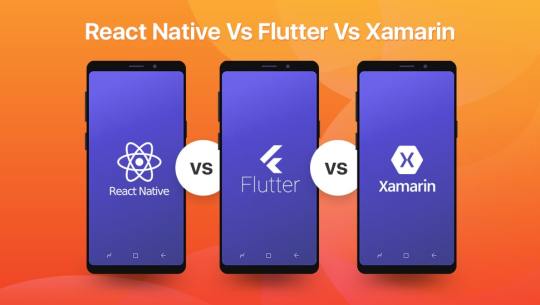
View On WordPress
0 notes
Text
When choosing between React Native and Flutter for your mobile app, consider Savvient Technologies' expertise. React Native offers seamless integration with JavaScript libraries, while Flutter provides a unified codebase for iOS and Android. Let Savvient guide your decision based on project needs and future scalability.
1 note
·
View note
Text

Flutter or React Native: Making the Decision in 2023
Deciding between Flutter and React Native in 2023? Get the insights you need to make the right choice in this expert guide.
#Flutter or React Native#React Native#Flutter#platform mobile app development#mobile app development#Flutter vs React Native
0 notes
Text
#React Native vs Flutter#React Native vs Flutter app development#flutter vs react native#hire flutter developers
1 note
·
View note
Text
PWA vs Native, Hybrid, SPA, MP: A Complete App Development Guide
In today's digital age, having a mobile app for your business is essential to stay ahead of the competition and cater to the growing needs of mobile users. However, when it comes to an app development company, there are several options to consider; one of them is Nivida Web Solutions Private Limited. Among the various approaches available, Progressive Web Apps (PWAs), Native apps, Hybrid apps, Single-Page Applications (SPAs), and Multi-Platform apps (MP) are the most popular choices. Each of these options has its own strengths and weaknesses. In this comprehensive app development guide, we will compare and contrast these different approaches to help you make an informed decision.
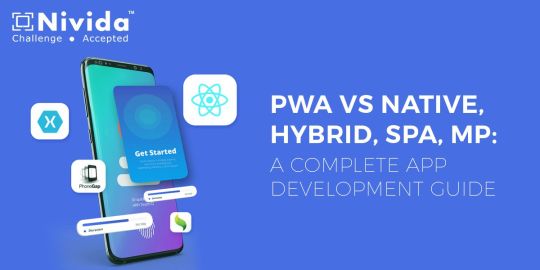
Progressive Web Apps (PWAs):
PWAs are web applications that are designed to look and function like native mobile apps. They are built using web technologies such as HTML, CSS, and JavaScript and are accessible through a web browser. PWAs are highly responsive, installable, and can work offline, making them an excellent choice for businesses looking to reach a wider audience across multiple platforms. Additionally, PWAs can be easily updated without requiring users to download new versions.
Native Apps:
Native apps are developed for specific platforms like iOS or Android using platform-specific languages (Swift or Objective-C for iOS, Java or Kotlin for Android). They offer the best performance, user experience, and access to device-specific features like camera, GPS, and push notifications. However, developing native apps requires separate codebases for different platforms, resulting in higher development costs and longer development cycles.
Hybrid Apps:
Hybrid apps are a combination of web and native apps. They are built using web technologies like HTML, CSS, and JavaScript and are wrapped in a native shell that enables them to be distributed through app stores. Hybrid apps provide a balance between cost-effectiveness and access to native features. However, they may not deliver the same performance as native apps, and certain device-specific functionalities might be limited.
Single-Page Applications (SPAs):
SPAs are web applications that load a single HTML page and dynamically update the content as users interact with the app. They offer a seamless user experience similar to native apps and can be accessed through web browsers. SPAs are easier to develop and maintain compared to native apps, but they may not provide the same level of performance and access to device features.
Multi-Platform Apps (MP):
Multi-platform apps are developed using cross-platform frameworks like React Native, Flutter, or Xamarin. These frameworks allow developers to write code once and deploy it across multiple platforms, saving time and effort. Multi-platform apps can achieve near-native performance and provide access to device features, making them a popular choice for businesses targeting multiple platforms.
When considering app development companies in India or Gujarat, it's essential to find a partner that understands your specific requirements and has expertise in the chosen development approach. Android App development companies in India and Gujarat offer a wide range of services, including native app development, hybrid app development, and PWA development. Similarly, Mobile App development companies in India and Gujarat can provide expertise in developing SPAs and MP apps.
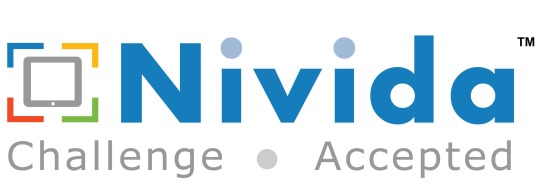
Before choosing an app development approach, consider factors such as budget, target audience, performance requirements, and time-to-market. Each approach has its own pros and cons, and the decision should align with your business goals and objectives. Consulting with a reputable app development company, Nivida Web Solutions Private Limited can help you navigate through these choices and make the right decision for your business.
In conclusion, the choice between PWAs, Native apps, Hybrid apps, SPAs, and MP apps depends on various factors such as performance, cost, development time, and target audience. Each approach has its own merits, and it's important to evaluate them based on your specific needs when selecting an app development company in India.
#eCommerce development company in India#eCommerce development Companies in Gujarat#Mobile App development Companies in India#Mobile App development company in Gujarat#Android App development Companies in India#Android App development company in Gujarat#Digital Marketing company in India
6 notes
·
View notes
Text
Top React Native App Development Companies to Work With in 2025
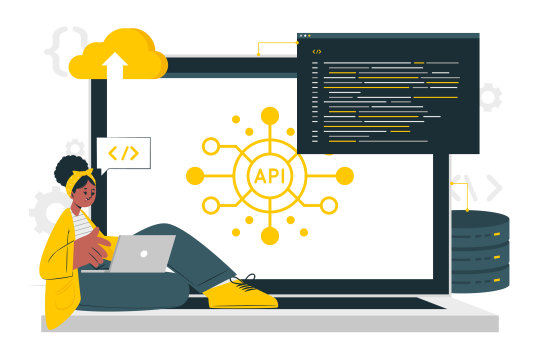
In today’s competitive digital world, businesses are constantly seeking ways to build fast, scalable, and cost-effective mobile apps. One solution that's leading the way is React Native app development. Known for its ability to create high-performing applications for both Android and iOS platforms using a single codebase, it has become the go-to framework for startups and enterprises alike.
The popularity of React Native app development stems from its flexible architecture, community support, and the ease it provides for integrating native modules. Whether you're launching a simple MVP or a feature-rich enterprise app, React Native simplifies the development process while ensuring a smooth user experience.
When it comes to Hybrid vs Native Apps, the debate continues—but React Native cleverly combines the best of both worlds. It allows developers to write once and deploy across platforms, reducing time-to-market and development costs significantly.
Moreover, if you’ve ever wondered, Which Mobile App Framework Suits Your Business – Flutter or React Native?, it's important to analyze your business goals, app complexity, and budget. While Flutter is growing in popularity, React Native offers better JavaScript support, larger community resources, and broader plugin availability.
A standout benefit of React Native app development is that it enables Cross platform development. This means fewer resources, faster testing, and easier maintenance—all while delivering native-like performance.
The Power of React Native in Modern App Development
React Native, backed by Facebook, uses JavaScript and React to build natively rendered apps. With features like hot-reloading, third-party plugin integration, and reusable components, it has become a favorite among developers and product teams.
An interesting trend is the rise of Detailed Tutorial on React Server Side, which showcases how server-side rendering (SSR) with React Native can improve load times, SEO performance, and user experience—especially for mobile web apps and hybrid solutions. Incorporating server-side rendering into your React Native app development process not only boosts performance but also helps in making applications more discoverable through search engines. Another key point to consider is scalability. React Native’s modular architecture and easy integration with native APIs make it ideal for businesses aiming for long-term growth and app flexibility.
Book an Appointment
Want to explore how React Native fits into your mobile strategy? Book an appointment with our React Native consultants today for a free demo and project roadmap.
Choosing the Right React Native App Development Partner
Choosing a trusted development partner can make or break your mobile strategy. The market is filled with numerous agencies and freelancers, but only a few offer proven expertise, full-stack capabilities, and tailored solutions.
That’s why we’ve curated a list of the Top 10 React Native App Development Companies that you can confidently collaborate with in 2025:
Toptal – Known for its elite pool of React Native developers.
MindInventory – Offers both React Native and backend services for full-stack development.
Appinventiv – Provides customized mobile solutions using React Native.
Netguru – Delivers quality UI/UX with React Native speed.
Simform – Offers agile development and enterprise-grade React Native apps.
GeekyAnts – Actively contributes to the React Native ecosystem.
Zco Corporation – Great for startups looking for cost-effective solutions.
WillowTree – Enterprise-level development with a design-first approach.
Fueled – Popular among funded startups.
Hidden Brains – Known for global delivery and scalable app solutions.
Partnering with these companies ensures your React Native app development process is seamless, strategic, and future-ready.
React Native vs Other Frameworks: A Practical Outlook
Let’s revisit the big question: Which Mobile App Framework Suits Your Business – Flutter or React Native?
While Flutter has its advantages like custom widgets and Dart-based programming, React Native still leads in terms of maturity, JavaScript ecosystem, and ready-to-use plugins. It's particularly ideal for businesses that already have web apps built with React.js.
React Native app development also offers easier integration with existing systems, especially if you’re planning a mobile-first transition from a traditional web-based system.
Additionally, businesses focused on scalability often leverage Cross platform development using React Native to maintain code consistency across devices and platforms. This not only accelerates deployment but also reduces ongoing maintenance overheads.
What’s New in React Native for 2025?
With every update, React Native evolves to offer more stability, performance, and developer tools. In 2025, the focus will shift further towards better support for Detailed Tutorial on React Server Side integration, accessibility improvements, and enhanced debugging tools.
Moreover, companies are investing in hybrid strategies due to growing confidence in the performance capabilities of React Native. The Hybrid vs Native Apps conversation is fading as businesses realize that hybrid frameworks like React Native can now deliver native-like speed, look, and feel. Still, if you're unsure, a good development company will help you decide the best fit based on your business requirements.
Final Thoughts
Whether you’re a startup or an enterprise, embracing React Native app development can significantly streamline your mobile strategy. It’s cost-effective, developer-friendly, and ideal for Cross platform development.
From enhancing your app’s performance using Detailed Tutorial on React Server Side to understanding the debate between Hybrid vs Native Apps, React Native continues to prove itself as a forward-looking solution. And when asking Which Mobile App Framework Suits Your Business – Flutter or React Native?, the answer increasingly favors React Native due to its maturity and community-driven growth.
When you're ready to transform your mobile app vision into reality, choosing from the Top 10 React Native App Development Companies can ensure your project is in expert hands.
So what are you waiting for? Your next big mobile success story begins with React Native app development.
0 notes
Text
How Can Companies Optimize ROI by Converting Android Apps to iOS (or Vice Versa)?
Optimize ROI by Converting Android Apps to iOS
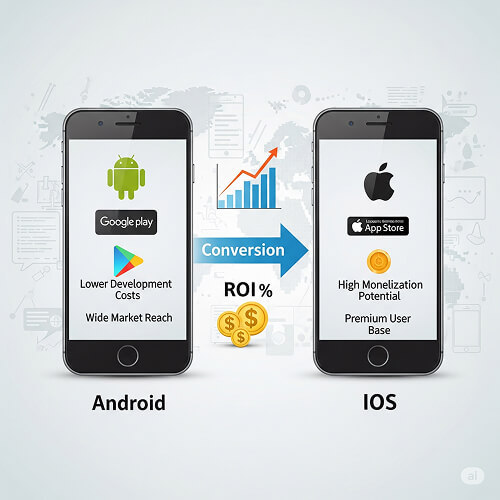
Introduction
In today’s mobile-first landscape, companies aiming to maximize their mobile app ROI must consider platform expansion. With Android dominating in user volume and iOS leading in revenue generation, converting your app from Android to iOS (or vice versa) can be a strategic move to reach a broader audience and boost profitability. This blog explores how app conversion can be a growth catalyst, helping businesses lower acquisition costs and increase user engagement across platforms.
Understanding Android to iOS App Conversion (or Vice Versa)
App conversion refers to the process of adapting an existing mobile application to operate on a different platform. Whether moving from Android to iOS or the reverse, this process involves more than just copying code. It includes reworking the UI/UX, adapting to platform-specific APIs, and ensuring functional parity across devices. Successful app conversion demands expertise in both Android and iOS app development to maintain performance and user satisfaction.
Top Reasons to Convert Android Apps to iOS (or Vice Versa)
Reach a wider audience: Tap into new user segments by expanding your presence to another platform.
Increase revenue potential: iOS users typically have higher lifetime value, while Android's larger user base can fuel ad-driven revenue models.
Improve brand presence: Being available on both platforms builds credibility and trust with users.
Maximize previous investments: Reusing assets and backend systems speeds up time-to-market and reduces development costs.
How App Conversion Improves ROI
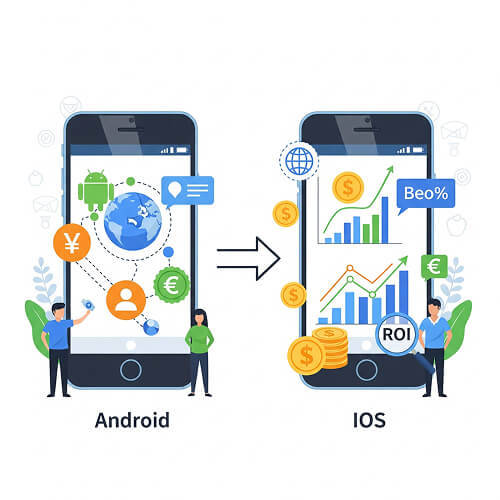
Converting your app allows you to scale without starting from scratch, which significantly lowers development costs. The ability to reach more users boosts installs, engagement, and revenue. Moreover, a cross-platform presence strengthens brand authority and opens doors to new monetization opportunities, like in-app purchases or subscriptions, ultimately maximizing return on investment.
Key Challenges in Mobile App Platform Conversion
UI/UX differences: iOS and Android have distinct design languages (Material vs. Human Interface Guidelines).
Technical variations: Differences in programming languages (Java/Kotlin for Android vs. Swift/Objective-C for iOS).
Third-party integration compatibility: Not all libraries and SDKs work identically across platforms.
Testing requirements: Each platform has its own device ecosystem and app store policies.
Steps to Successfully Convert Your Mobile App
Audit existing app code and features
Choose the right development approach (native or cross-platform)
Redesign UI/UX to fit the new platform standards
Adapt backend APIs and third-party services
Test extensively across devices and OS versions
Deploy to the relevant app store with optimized listings
Tools & Technologies for App Conversion
Flutter: Ideal for creating a single codebase for both platforms
Kotlin Multiplatform: Enables code sharing between Android and iOS
React Native: Popular framework for cross-platform mobile development
Xamarin: Microsoft-backed tool for .NET-based apps
Choosing the right tech stack depends on performance needs, UI complexity, and existing code structure.
Cost Estimation & ROI Forecasting

App conversion is typically more cost-effective than building a new app from scratch. Factors affecting cost include app complexity, UI redesign, and backend changes. Companies should calculate potential ROI by comparing conversion cost with projected increase in user acquisition, engagement, and revenue across the new platform.
Case Studies: App Conversion Success Stories
Example 1: A retail app that expanded from iOS to Android and saw a 40% increase in monthly active users
Example 2: A SaaS product that moved from Android to iOS, leading to a 30% boost in in-app purchases These examples showcase how strategic app conversion can result in measurable growth.
Tips to Maximize ROI After Converting Your App
Invest in App Store Optimization (ASO) for visibility
Launch targeted marketing campaigns on the new platform
Monitor analytics closely to track engagement and retention
Solicit user feedback to continuously refine the app experience
Conclusion
Converting your Android app to iOS or vice versa is not just a technical decision—it's a business strategy. When done right, it can significantly enhance user reach, reduce development overhead, and boost ROI. By partnering with an experienced app development company like CQLsys Technologies, you can ensure a smooth transition and unlock new growth opportunities across platforms.
#AppMigration#MobileStrategy#AppMarketing#TechROI#DigitalGrowth#AppScaling#iOSDeveloper#AndroidDeveloper#MobileSolutions#BusinessTech#UserEngagement#RevenueGrowth#AppUpgrade#TechTips#CQLsysTech#Innovation
0 notes
Text
Mobile App Development Secrets for 2025

In our hyper-connected world, mobile apps drive everything—from grabbing your morning coffee to handling your finances. Behind every amazing app lies a technology stack that not only powers great performance but also sets the stage for future growth. Whether you're starting with a minimum viable product (MVP) or mapping out a full-scale digital strategy, choosing the right development tools is critical.
What Are Mobile App Development Technologies?
Mobile app technologies include all the programming languages, frameworks, platforms, and tools used to build apps for your smartphone or tablet. Think of it like crafting your favorite recipe: you need the right ingredients to create something truly special. The choices you make here influence the development speed, cost, performance, and overall user experience of your app.
Native vs. Cross-Platform Development: Finding Your Fit
One of the biggest early choices is whether to go native or cross-platform. Let’s break it down:
Native Mobile App Development
Native apps are developed specifically for one platform—either iOS or Android, using platform-centric languages (Swift for iOS or Kotlin for Android). This approach offers best-in-class performance, smoother integration with device hardware, and top-tier user experiences.
Pros:
Best performance
Full access to device features (think camera, GPS, etc.)
Seamless updates with the operating system
Cons:
Requires two separate codebases if you need both iOS and Android
Typically more time-consuming and expensive
Ideal for high-demand sectors such as banking, gaming, healthcare, or AR/VR applications.
Cross-Platform Mobile App Development
Frameworks like Flutter and React Native let you craft a single codebase that deploys across both iOS and Android. This approach is great for faster development, reduced costs, and consistent design across platforms—but might trade off a bit on native performance.
Pros:
Quicker turnaround and lower development costs
Consistent UI experience across devices
Cons:
May have limited access to some native device features
Slight performance differences compared to native solutions
Perfect for startups, MVPs, and businesses with tighter budgets.
The Leading Frameworks in 2025
Let’s look at some of the coolest frameworks shaking up mobile app development this year:
Flutter
Language: Dart
By: Google
Flutter is renowned for its beautifully customizable UIs and high performance across different platforms using just one codebase. It’s a favorite if you need a dynamic, pixel-perfect design without the extra overhead.
React Native
Language: JavaScript
By: Meta (Facebook)
If you’re from a web development background, React Native feels like home. It uses reusable components to speed up prototyping and quickly bring your app to life.
Kotlin Multiplatform
Language: Kotlin
By: JetBrains and Google
A newer, exciting option, Kotlin Multiplatform allows for sharing core business logic across platforms while giving you the flexibility to build native user interfaces for each.
Swift and SwiftUI
Language: Swift
By: Apple
For purely iOS-focused projects, Swift combined with SwiftUI offers robust performance and a seamless integration with the Apple ecosystem, perfect for apps needing advanced animations and responsiveness.
Hybrid Approaches
Using web technologies like HTML, CSS, and JavaScript wrapped in native containers, hybrid apps (via frameworks like Ionic or Apache Cordova) let you quickly convert an existing website into a mobile app. They’re great for rapid development but might not always match the performance of native apps.
Trends Shaping Mobile App Development
Looking ahead to 2025, several trends are redefining how we build mobile apps:
Next-Level AI and Machine Learning: Integrating on-device AI (using tools like Core ML or TensorFlow Lite) can help personalize experiences and power innovative features like voice assistants.
Wearable Integration: With the rise of smartwatches and fitness trackers, native development for wearables is booming.
5G and Real-Time Experiences: As 5G networks expand, expect more apps to offer real-time features and smoother interactions, especially in areas like gaming and AR.
Low-Code/No-Code Platforms: For rapid prototyping or internal tools, platforms that simplify app creation without deep coding knowledge are becoming increasingly popular.
Choosing the Right Tech for Your App
Before you jump into development, ask yourself:
What’s Your Budget?
Limited funds? Cross-platform options like Flutter or React Native might be perfect.
Budget is less of an issue? Native development can deliver that extra performance boost.
How Fast Do You Need to Launch?
If time-to-market is key, cross-platform frameworks speed up the process.
For a more robust, long-term solution, native apps may be worth the wait.
Which Features Are Essential?
Need deep hardware integration? Native is the way to go.
For straightforward functionality, a hybrid approach can work wonders.
What’s Your Team’s Expertise?
A team comfortable with web technologies might excel with React Native.
If your developers are seasoned in iOS or Android, diving into Swift or Kotlin may yield the best results.
Final Thoughts
There isn’t a magic bullet in mobile app development—the best choice always depends on your unique objectives, budget, timeline, and team. If you’re looking for high performance and don’t mind investing extra time, native development is ideal. However, if speed and cost-efficiency are your top priorities, cross-platform frameworks like Flutter or React Native offer tremendous value.
At Ahex Technologies, we’ve partnered with start-ups, small businesses, and enterprises to build tailored mobile solutions that fit their exact needs. Whether you’re at the ideation stage or ready to scale up, our team is here to help you navigate the tech maze and set your app up for long-term success.
Questions or Thoughts?
I’m curious, what trends in mobile app development are you most excited about for 2025? Feel free to share your insights, ask questions, or start a discussion right here. Let’s keep the conversation going!
#ahex technologies#android mobile app development company#android application development company#mobile application development#mobile app development
0 notes
Text
Getting Started with Mobile App Development: A Practical Guide for Beginners and Businesses

In today's fast-moving digital world, mobile apps are no longer a luxury—they’re a necessity. Whether you're a startup founder, a healthcare innovator, or a business owner trying to modernize operations, diving into mobile app development is one of the smartest moves you can make. From idea to execution, the journey may feel overwhelming at first, but once you break it down, it's surprisingly achievable.
Let’s walk through what it really takes to get started with mobile app development—specifically for iOS platforms, hiring the right team, and creating something impactful, like a healthcare mobile app that could truly change lives.
Why Mobile App Development Matters More Than Ever
We live in a world where everything—banking, shopping, learning, and even managing health—is handled through smartphones. Apps aren’t just about convenience anymore; they’re about delivering value at the speed of life.
For businesses, a mobile app opens doors to direct customer engagement, streamlined operations, and new revenue streams. For users, it means instant access to solutions they need, right in their pockets.
Whether you’re a founder or a product manager, understanding the fundamentals of mobile app development will give you a strategic advantage. And if you're operating in industries like healthcare, that knowledge could empower you to create apps that genuinely improve patient outcomes.
Choosing the Right Platform: iOS vs Android
One of the first choices you’ll face is whether to build your app for iOS or Android. Ideally, you’d do both. But if you're just starting out, iOS often makes for a smoother entry point.
Why iOS?
Higher Revenue Potential: iOS users tend to spend more on apps and in-app purchases.
Consistency Across Devices: Unlike Android’s fragmented device ecosystem, iOS development focuses on a limited set of Apple devices, making testing and optimization easier.
Security: Apple’s stringent app review process ensures a safer ecosystem, which is especially important for apps dealing with sensitive data, like healthcare mobile apps.
While Android commands a larger global market share, many startups choose to build for iOS first, learn from user behavior, and then scale to Android.
Hiring the Right Team: The Power of Skilled Developers
You might be wondering: Should I learn to code myself? While tools like Flutter or React Native offer beginner-friendly ways to prototype apps, scaling a high-quality application usually means you need to hire mobile app developers.
Here's why a professional team is crucial:
Experience: Skilled developers know how to turn your vision into a polished, scalable app.
Efficiency: They save you time by avoiding common pitfalls.
Security & Compliance: Especially in sectors like healthcare, you need people who understand regulations like HIPAA and know how to build secure apps.
When choosing developers, look for a team that has experience in your niche. For example, if you’re building a medical app, you’ll want developers who have built healthcare mobile app development projects before. This is not just about writing code—it’s about understanding user needs, compliance, and integrating with systems like EMRs or wearable devices.
A great example of a company that bridges this gap is SMTlabs. They’ve worked on scalable app solutions across various industries, including healthcare, helping clients bring their vision to life with speed and precision.
Healthcare Mobile App Development: Building for Trust and Impact
If you're thinking about building a healthcare mobile app, congratulations—you’re stepping into a space with real potential to change lives. But this also means extra responsibility.
Here’s what you need to keep in mind:
User Privacy: Data sensitivity in healthcare is unmatched. You'll need to comply with regulations like HIPAA (in the U.S.) or GDPR (in the EU).
User Experience: The people using your app might be seniors, patients recovering from surgery, or overworked healthcare professionals. Simplicity is everything.
Integration: Many healthcare apps need to talk to other platforms—like Apple Health, FitBit, or hospital databases. Building these connections securely is a job for pros.
In healthcare, trust is everything. A small bug or confusing interface can cost not just users, but reputations. That’s why hiring experienced developers with a healthcare portfolio is non-negotiable.
From Idea to Launch: The Development Process
Whether you’re launching a telehealth platform or a simple fitness tracker, the development process usually includes:
Discovery Phase: Define your app’s purpose, target audience, and key features.
Wireframing & Design: Create mockups of the user interface.
Development: Code the app’s front-end (user interface) and back-end (server, databases).
Testing: Debugging, performance optimization, and user feedback.
Launch & Maintenance: Submit to app stores, monitor performance, and release updates.
And don’t forget post-launch support. The best apps evolve based on user feedback.
What About Budget?
Costs vary widely. A basic iOS app might cost $10,000 to $30,000. A complex healthcare mobile app could run upwards of $100,000, depending on features and security requirements. Hiring offshore developers can lower costs, but be cautious—poor code quality often leads to expensive rewrites.
Instead, work with a trusted partner who understands your vision. For example, a company like SMTlabs offers strategic consultation along with development services, ensuring you're building something both useful and scalable.
Final Thoughts
Starting your mobile app development journey might seem daunting, but it’s absolutely within reach. Whether you're building for iOS users, targeting the healthcare industry, or looking to hire mobile app developers who truly understand your vision, the key is to start with clarity and align with the right partners.
Mobile apps aren’t just digital tools anymore—they’re bridges between businesses and people, ideas and solutions, care and connection.
And if you're looking for a team to help you cross that bridge, SMTlabs has a proven track record of delivering results in some of the most demanding industries, healthcare included.
#mobile app development#flutter app development#ios development#hire developers#mobile application development#mobile app developers
0 notes
Text
Native vs. Hybrid App Development — My Honest Take

Alright, let me just say this up front — if you're building an app, choosing between native and hybrid isn’t as complicated as people make it sound. But yeah, it does matter.
Running an app development company in Bhopal, I’ve had this conversation more times than I can count. So, instead of another techy breakdown, here’s a real-world explanation — no fluff, no buzzwords.
So, What Even Is a Native App?
Basically, a native app is built only for one platform — either Android or iOS. So yeah, if you want both, you build it twice. Painful, I know.
Why do people still do it? Because native apps run smoother. They look better, feel faster, and get access to everything your phone offers — from the camera to those tiny motion sensors nobody talks about.
Also Read: Why I Think You Should Hire a Digital Marketing Agency in Bhopal in 2025
But here's the catch: it takes longer and costs more. You need two dev teams (or one very tired one), and updates? You’ve gotta do those twice too.
And Hybrid?
A hybrid app is a bit of a shortcut — but a smart one. You write the code once, and it runs on both Android and iOS. Tools like Flutter or React Native help a lot with this.
I’ve seen startups launch solid products this way. It’s faster, way cheaper, and easier to maintain. For 90% of business apps, it gets the job done — and users don’t even know the difference.
But yeah — it might lag a bit if the app’s super heavy. And if you want some cutting-edge phone feature, hybrid might struggle to keep up.
Here’s What I Tell Clients
If you’re building an MVP, or just testing an idea — go hybrid. Save money. Move fast.
If performance is everything (like a mobile game, or something users use daily for long hours), native is the way to go.
Also Read: best digital marketing companies in Bhopal
It really depends on the use case, not what’s trending on LinkedIn this week.
Last Thought
You don’t need to figure it all out alone. If you're still stuck, feel free to ping us. We’re a local app development company in Bhopal, and we’ve built both kinds of apps — for small startups and big businesses alike.
Sometimes all it takes is a short call to get clarity.
0 notes